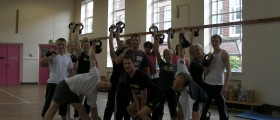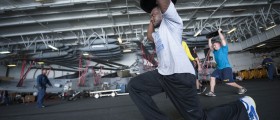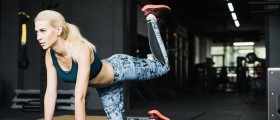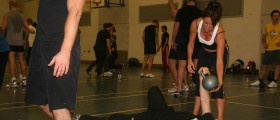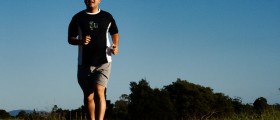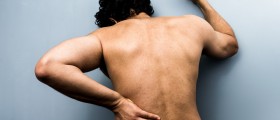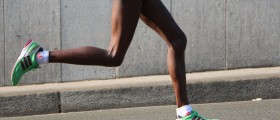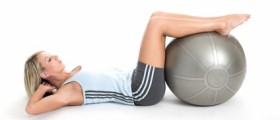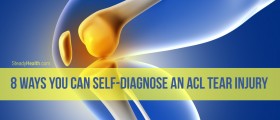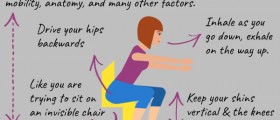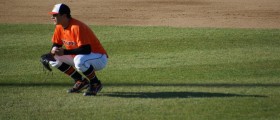Loading...
Loading...
For example, the leading cause of death in women over age 70 is falling. Right-hand dominant persons tend to also be right-foot dominant persons. They kick (e.g., a soccer ball) with their right foot. Thus, while kicking, they stabilize, plant or balance with their left foot. Through practice, their left foot (and left lower extremity) becomes good at balance. Problems with balance occur on their right foot and can lead to falls.
On the other hand (pun intended), leg length inequality can lead to problems. Those problems could be either on the left or the right, depending on the sport or activity, or depending upon the individual and his/her movement patterns.
Scoliosis and milder spinal curvatures lead to asymmetry in the frontal plane and can cause problems on either side. Most scoliosis leads to left convex lumbar curvature and right convex thoracic curvature. Most people with scoliosis will be stronger in their right quadratus lumborum musculature and that asymmetry will usually lead to low back pain with tightness and pain on the right. But that has nothing to do with hand dominance.
Other examples exist, but are not related to hand dominance, necessarily. One that does relate to hand dominance is the rotator cuff (i.e., shoulder). Insidious onset shoulder pain in women is more likely going to occur in the non-dominant shoulder through disuse atrophy of the rotator cuff muscles on the non-dominant side.
So, it's not that simple, no.
Loading...
The ITB, low back and hamstring are very closely connected and commonly play off one another. We call it "the kinetic chain". A few questions: what occurred first in your life? low back pain, hamstring problems or ITB issues? Tell me more.
Loading...
the hamstring pain definitely occurred first. is it overstretched, overtight, too weak? i tried all treatments but it still hangs in there.
then, a severe ITB episode had me out for months two years ago; i got orthotics and kept mileage down and it seemed to be fine.
low back pain and tightness seemed to come on next. i regularly do the catback stretch and see a chiropractor once a month now for adjustments.
i just can't shake the ITB this time :x
i wear a neutral cushioned shoe that wears on the outside consistently.
weigh 130 lbs, 5 ft. 7 and am 47 yo female and like to do 30-35 mpw.
Loading...
the hamstring pain definitely occurred first. is it overstretched, overtight, too weak? i tried all treatments but it still hangs in there.
then, a severe ITB episode had me out for months two years ago; i got orthotics and kept mileage down and it seemed to be fine.
low back pain and tightness seemed to come on next. i regularly do the catback stretch and see a chiropractor once a month now for adjustments.
i just can't shake the ITB this time :x
i wear a neutral cushioned shoe that wears on the outside consistently.
weigh 130 lbs, 5 ft. 7 and am 47 yo female and like to do 30-35 mpw.
Who told you that your right leg is shorter than your left? That conclusion cannot be drawn by looking. It also cannot be made from a standing x-ray of the pelvis due to magnification problems with x-rays. A measurement must be made by hand, and one has to be sure. That measurement is made from the anterior superior iliac spine (ASIS) to the medial malleolus (inside "ankle bone") with a flexible tape measure, and it has to be performed three times giving an average. The problem with that traditional orthopaedic measurement is that it does not take into account the height of the foot (i.e., heel). Until that measurement is taken, you do not know if it's true. You should find out.
If your hamstring pain came first, it could have been sciatica, but the chiropractor should have ruled that out. What was the diagnosis originally for that pain? Was it muscle strain? You're asking me to give you an answer, but there is no way anyone could give you the answer over the internet. Your doctor should have given you that.
Okay, you saw one of my colleagues. What is the chiropractor's diagnosis of your right low back pain (LBP)? Is it a multifidus strain? A quadratus lumborum strain? Is it osteoarthritis? Is it another muscle strain? Is it discogenic (related to a disc)? You need to know. If that chiropractor cannot give you a precise diagnosis of your problem, then find another DC. Cat/camel stretches are good stretches, but they may not be enough.
Are you having pain during runs? Just after? The next day? What is the timing of symptoms? By the way, iliotibial band syndrome is a KNEE problem. Is that what you have? Have you tried massage for the ITB?
Tell me more about those miles you run. You said 30-35 mi per week. Do you run hills? Flats only? Do you run the same distance every day? Do you do recovery runs? Easy-hard days? Tell me more. You deserve some answers.
Loading...
Who told you that your right leg is shorter than your left? That conclusion cannot be drawn by looking. the former chiro told me and he did measure, i seem to remember across my leg kinda. i can't speak to the "heel" issue though, i don't recall if he considered that. he did do it on more than one visit. i had also seen an ortho surgeon at one time and he did some kind of measure as well and reco'd this huge clunky thing be put into my shoe :umno: i wore it for a SHORT while before i decided it was totally assenine.
i will have pain midrun, around 8 miles. i can, however, go out and run a hard 9 miles with no pain but the next days run will have onset pain at around 3 miles. no after run pain at all. i use "the stick" on my ITB, i use a tennis ball on the TFL, and i do the typical ITB stretch when you cross your affected leg behind the other and sidebend. i do notice a snap when i do this stretch, all the time, as if the tendon is slipping over a bone or off a bone and then there's a postural change. nothing like that with the other leg. it's a definite slippage...very odd. Tell me more about those miles you run. You said 30-35 mi per week. Do you run hills? Flats only? Do you run the same distance every day? Do you do recovery runs? Easy-hard days? Tell me more. You deserve some answers. of my total week's miles, i do one hilly run of 4 - 6 miles outdoors. i do one speed workout on a flat treadmill (mile intervals ) and the rest are usually just tempo runs on an inclined treadmill or at a track that is flat. most of my running is on a treadmill. i find it more than frustrating that i've attempted to self treat myself for years now because there just seems to be NO real answers out there. or maybe it's just me. :|
Loading...
Simple, but stupid: what type of purse do you carry, which hand do you carry it in, and how heavy is it?
Loading...
:1: my mother's purse was 25 pounds. it caused her all kinds of issues. in my case i tend to have my injuries on my left side, cause by multiple resaons but mainly do to the fact i try to protect my right hand at all costs.not trying discredit DrWright though, just some simpler reasons.
Loading...
No, definitely not discrediting the doc, merely mentioning that some of my pain is alleviated by not carrying a purse--and it's mostly on my left side, too.
Loading...
not stupid at all. i have long thought that that STUPID purse hanging on my right shoulder my entire life has probably had something to do with it. i try to carry it in my hand now, without hanging it on the shoulder ever. it's a point well taken aire; i think there's a strong possibility that shoulder bags can wreak havoc on one's posture.
